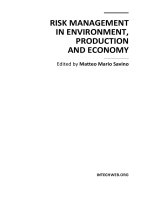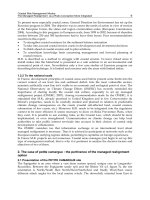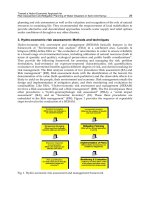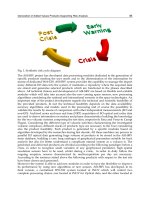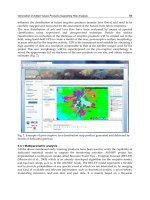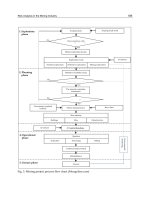Risk management in finance six sigma and other next generation techniques (wiley finance)
Bạn đang xem bản rút gọn của tài liệu. Xem và tải ngay bản đầy đủ của tài liệu tại đây (3.65 MB, 358 trang )
Risk
Management
in Finance
Six Sigma and Other
Next-Generation Techniques
ANTHONY TARANTINO
DEBORAH CERNAUSKAS
John Wiley & Sons, Inc.
Risk
Management
in Finance
Founded in 1807, John Wiley & Sons is the oldest independent publishing company in the United States. With offices in North America, Europe, Australia, and
Asia, Wiley is globally committed to developing and marketing print and electronic
products and services for our customers’ professional and personal knowledge and
understanding.
The Wiley Finance series contains books written specifically for finance and
investment professionals as well as sophisticated individual investors and their financial advisors. Book topics range from portfolio management to e-commerce, risk
management, financial engineering, valuation, and financial instrument analysis, as
well as much more.
For a list of available titles, please visit our Web site at www.WileyFinance.com.
Risk
Management
in Finance
Six Sigma and Other
Next-Generation Techniques
ANTHONY TARANTINO
DEBORAH CERNAUSKAS
John Wiley & Sons, Inc.
Copyright
C
2009 by John Wiley & Sons, Inc. All rights reserved.
Published by John Wiley & Sons, Inc., Hoboken, New Jersey.
Published simultaneously in Canada.
No part of this publication may be reproduced, stored in a retrieval system, or transmitted in
any form or by any means, electronic, mechanical, photocopying, recording, scanning, or
otherwise, except as permitted under Section 107 or 108 of the 1976 United States Copyright
Act, without either the prior written permission of the Publisher, or authorization through
payment of the appropriate per-copy fee to the Copyright Clearance Center, Inc., 222
Rosewood Drive, Danvers, MA 01923, 978-750-8400, fax 978-646-8600, or on the web at
www.copyright.com. Requests to the Publisher for permission should be addressed to the
Permissions Department, John Wiley & Sons, Inc., 111 River Street, Hoboken, NJ 07030,
201-748-6011, fax 201-748-6008, or online at />Limit of Liability/Disclaimer of Warranty: While the publisher and author have used their
best efforts in preparing this book, they make no representations or warranties with respect
to the accuracy or completeness of the contents of this book and specifically disclaim any
implied warranties of merchantability or fitness for a particular purpose. No warranty may
be created or extended by sales representatives or written sales materials. The advice and
strategies contained herein may not be suitable for your situation. You should consult with a
professional where appropriate. Neither the publisher nor author shall be liable for any loss
of profit or any other commercial damages, including but not limited to special, incidental,
consequential, or other damages.
For general information on our other products and services, or technical support, please
contact our Customer Care Department within the United States at 800-762-2974, outside
the United States at 317-572-3993 or fax 317-572-4002.
Wiley also publishes its books in a variety of electronic formats. Some content that appears
in print may not be available in electronic books.
For more information about Wiley products, visit our Web site at .
Library of Congress Cataloging-in-Publication Data:
Tarantino, Anthony, 1949–
Risk management in finance : six sigma and other next generation techniques / Anthony
Tarantino, Deb Cernauskas.
p. cm.
Includes bibliographical references and index.
ISBN 978-0-470-41346-3 (cloth)
1. Financial risk management. I. Cernauskas, Deb, 1956– II. Title.
HG173.T346 2009
658.15 5–dc22
2008052035
Printed in the United States of America
10 9 8 7 6 5 4 3 2 1
To Winkey, Peapod, and SanSan
—A.T.
To Mom for her continued support
—D.C.
Contents
Preface
xv
Acknowledgments
xix
About the Contributors
xxi
CHAPTER 1
Introduction
Organization of This Book
Why Read This Book?
Note
CHAPTER 2
Data Governance in Financial Risk Management
Introduction
Data Governance Center of Excellence
Data Governance Assessment
Data Governance Maturity Model
Best Practices in Data Governance
Conclusion: Next-Generation Techniques to Reduce Data
Governance Risk
Notes
CHAPTER 3
Information Risk and Data Quality Management
Introduction
Organizational Risk, Business Impacts, and Data Quality
Examples
Data Quality Expectations
Mapping Business Policies to Data Rules
Data Quality Inspection, Control, and Oversight: Operational
Data Governance
Managing Information Risk via a Data Quality Scorecard
Summary
Notes
1
3
4
4
5
5
6
8
8
10
12
13
15
15
15
17
19
21
21
22
24
24
vii
viii
CONTENTS
CHAPTER 4
Total Quality Management Using Lean Six Sigma
Introduction
Performance Targets
Process for Excellence
Process Improvement
Summary
CHAPTER 5
Reducing Risk to Financial Operations through Information Technology
and Infrastructure Risk Management
Introduction
The Problem
Risk Source and Root Cause
Risk Management
Closing Comments
Global IT Standards Matrix
Links to IT Risk Associations and Agencies
CHAPTER 6
An Operational Risk Management Framework for All Organizations
Introduction
Definition and Categorization of Operational Risk
How Auditors and Regulators Approach Risk Management
How Rating Agencies Evaluate Operational Risk
An Operational Risk Framework for All Organizations
Conclusion
CHAPTER 7
Financial Risk Management in Asia
Introduction
Risks in Asian Supply Chains
Risks in Asian Financial Markets
Conclusion
Notes
CHAPTER 8
Doing Business in Latin America: Lessons Learned and Best Practices
for the Protection of Foreign Investors
Introduction
The World Bank Indicators
Protection of Debt Investors
Protection of Minority Owners
Conclusion
CHAPTER 9
Mitigating Risk Exposure in Transitioning to the IFRS
Introduction
Revenue Recognition Risks (IAS 18)
27
27
28
30
31
35
37
37
37
42
43
45
47
49
53
53
54
56
57
57
59
61
61
63
67
73
73
75
75
76
79
82
85
87
87
90
Contents
Derivatives (IAS 39) and Hedging Risks
Share-Based Compensation and Pension Risks
Nonfinancial Asset Risks
Off-Balance-Sheet Risks (Financial Assets)
Tax Liability Risks
Other Liability Risks
Financial Liabilities and Equity Risks
Business Combination Risks (Mergers and Acquisitions)
Financial Services Industry Risks
Conclusion: Suggestions to Reduce the Conversion Risks
Notes
CHAPTER 10
Quantitative Operational Risk Management Methods
Introduction
Operational Risk Overview
Quantitative Methods
Modeling Approach Operational Risk
Operational Value at Risk
Multifactor Causal Models
Regime Switching Models
Discriminant Analysis
Bayesian Networks
Process Approach to Operational Risk
Business Process Modeling and Simulation
Precursor Analysis in Operational Risk Management
Agent-Based Modeling
Six Sigma Approach to Quality and Process Control: Failure
Modes and Effects Analysis
Conclusion
Bibliography
Notes
CHAPTER 11
Statistical Process Control Integrated with Engineering Process Control
Introduction
Control Schemes
Statistical Process Control
Engineering Process Control Systems
Finance Example
Conclusion
Bibliography
Notes
CHAPTER 12
Business Process Management and Lean Six Sigma:
A Next-Generation Technique to Improve Financial Risk Management
Background
Historical Perspective
ix
91
93
94
94
96
96
97
97
99
100
101
103
103
105
106
107
107
108
109
110
111
111
111
112
113
113
115
115
116
117
117
118
119
121
125
130
130
130
131
131
133
x
CONTENTS
BPM in Financial Services—Functionality to Look For
Survey of Cross Industry Deployments of BPM Solutions
Benefits of BPM over Traditional Process Development
Pulte Mortgage Case Study
Ameriprise Financial Case Study
Lean Six Sigma’s SIPOC Approach to BPM
Conclusion
Notes
CHAPTER 13
Bayesian Networks for Root Cause Analysis
Introduction: Risk Quantification in Finance
Causal Knowledge Discovery
Bayesian Networks
Conclusion
Bibliography
CHAPTER 14
Analytics: Secrets to Deriving Business Value and Insights
out of Information
Abstract
Introduction
Information Technology and Service Evolution
Information Analytics Technology Landscape
Future Analytics Technologies
Conclusion
Notes
CHAPTER 15
Embedded Predictive Analytics: Transforming Risk Management from
Review Function to Competitive Advantage
Introduction
Execution Risk in the Financial Services Industry
Business Processes
Predictive Analytics: Technology-Enabled Analytic Methods
Conclusion: Managing Risk Competitively
CHAPTER 16
Reducing the Financial Risks in Litigation and Legal Discovery
Background
The Sedona Conference and the New Rules of Civil Procedure
U.S. Court Rulings under the New FRCP
U.S. Rulings Impacting Businesses Outside the United States
Best Practices and Next-Generation Techniques
Conclusion
Notes
134
135
136
136
136
137
139
142
143
143
144
147
151
151
153
153
154
155
156
166
167
167
171
171
171
172
173
180
183
183
184
189
192
193
195
195
Contents
CHAPTER 17
The Circle of Trust
Introduction
Is Three Sigma Good Enough?
Economic Value of a Sigma
The Six Sigma Audit
Conclusion
Notes
CHAPTER 18
Reducing Liability Risk through Best Environmental Practices
Introduction
The Economy and the Environment
Environmental Risks: Risks and the Securities and Exchange
Commission (SEC)
Impact of Industrial Environmental Management on Firms
Competitive Advantage
Shift in Industrial Ecosystem toward Sustainability
Industrial Profitability and Sustainable Development
Pollution Trading and Firms Financial Performance
Conclusion
Notes
Bibliography
CHAPTER 19
Beyond Segregation of Duties: Next-Generation Techniques in
Evaluating User Access Control Risks
Introduction
User Access Controls, Not Just Segregation of Duties
Risk Assessment Methodology
The Next Generation of Segregation of Duties: User Access Controls
Current State and Future Direction of Risk Advisory and Audit Firms
Current State and Future Direction of ERP Software Vendors
Conclusion
Notes
CHAPTER 20
Transaction-Based Cross-Enterprise Risk Management
Overview
Background
Basel II and Current U.S. Implementation
Current State of Enterprise Risk Management
Financial Accounting versus Risk Accounting
10 Principles of Effective Enterprise Risk Management
A Transactional Approach
Cross-Enterprise Solution
Predictive Risk Models
Conventional Solutions versus Cross-Enterprise Process
xi
197
197
198
199
200
202
202
203
203
205
206
208
210
212
214
215
215
218
219
219
219
220
221
227
230
231
232
233
233
234
235
236
240
240
241
244
250
251
xii
CONTENTS
Conclusion
Notes
CHAPTER 21
Throughput Accounting
Background
The Five Focusing Steps
Throughput Accounting
Elements of Throughput Accounting
Evaluating Financial Decisions
Role of a Constraint
Applying T, I, and OE to Traditional Business Measures
Product Cost—Throughput Accounting versus Cost Accounting
Analyzing Products Based on Throughput per Constraint Unit
How Can a Company Increase T/CU?
Key Decisions Areas to Apply Throughput Accounting
Summary
Appendix: Common Questions and Answers
Notes
CHAPTER 22
Environmental Consistency Confidence: Scientific Method in Financial
Risk Management
Introduction
Paradigms Applied—Values, Control, Reengineering, and Costing
Environmental Consistency Confidence—Statistical Head,
Cultural Heart
What Is a Key Risk Indicator (KRI)?
Case Study: Global Commodities Firm
Predictive Key Risk Indicators for Losses and Incidents
(PKRI LI) Issues
Case Study: European Investment Bank
What Is Current Practice?
Bigger Canvases for Scientific Management
Conclusion
Bibliography
Notes
CHAPTER 23
Quality in the Front Office: Reducing Process Variation
in Trading Firms
Introduction
Development Methodology for Quantitatively Driven Projects
in Finance
Waterfall Process for Continuous Improvement (Kaizen)
Conclusion
Notes
254
255
257
257
258
259
260
261
262
263
264
266
268
269
270
271
272
273
273
275
276
277
278
280
280
283
285
286
287
287
289
289
290
296
296
296
Contents
CHAPTER 24
The Root Cause of the Global Financial Crisis and Corporate Board
Reforms to Prevent Future Failures in Risk Management
Introduction
Background to the Global Financial Crisis of 2007–2009
Why This Crisis Deserves Close Scrutiny
The Root Cause of Catastrophic Failure in Financial Risk
Management
How to Prevent Future Failures in Financial Risk Management
Conclusion
Notes
Index
xiii
299
299
299
300
301
303
318
319
321
Preface
ccording to the Book of Genesis, God decided to destroy the world in a great
flood because of mankind’s sinful and wicked ways. But God knew Noah was
a righteous man and decided to spare him and his family. He instructed Noah to
build an ark, a very large vessel of no economic or recreational value, to hold Noah’s
family and representatives from the animal kingdom. While there was no business
case or quantitative or qualitative risk model to justify this endeavor, Noah decided
to mitigate his risk and build the ark. We can imagine that conventional wisdom
of the time condemned Noah for such a foolish waste of time and money and that
community and media reaction would have been very negative as well.
Noah’s risk mitigation proved to be quite timely as conventional wisdom and
traditional risk management failed in a catastrophic manner. Noah survived the great
flood and began rebuilding civilization after the waters of the great flood receded.
Some time later, Toyota, a Japanese car manufacturer, decided to build a hybrid
car to mitigate the risk of rising fuel prices and need to curtail greenhouse gases.
As with Noah, there was no valid business case or accepted risk model to justify
such a foolish waste of time and money. Conventional wisdom of the time was that
large gas-guzzling vehicles were the safe choice. They were all the rage and generated
very high returns. Fuel-efficient cars were much less profitable and lacked the status
and prestige of larger and more muscular vehicles. As with Noah, we can imagine
industry leaders making fun of such a wimpy car that would appeal only to a small
number of tree-hugging environmentalists on the American West Coast.
Again, conventional wisdom and traditional risk management failed in a catastrophic manner. The energy crisis and push for green energy made the little hybrid
car a huge success and helped propel Toyota into a leadership position as the
most profitable and best-capitalized manufacturer in the industry. Conversely, their
American competitors are now on the verge of bankruptcy and capitalized below
their World War II levels.
A few years ago, Wells Fargo decided that the risk inherent in the subprime mortgage market was unacceptable, and minimized their exposure. Again, the conventional wisdom and accepted quantitative and qualitative risk models argued against
their conservatism. Profit margins for subprime mortgages, mortgage-backed securities, and credit default swaps were much higher than the more traditional vehicles and
instruments offered by banks. Government regulators, rating agencies, and business
media all promoted the subprime market, either directly or indirectly. This created
shareholder pressures to jump into this very lucrative market. As with Noah and
Toyota, media and public reaction was negative to Wells Fargo’s conservative approach to risk mitigation. As with Noah and Toyota, we can imagine industry leaders
making fun of a bank with a stagecoach as a corporate symbol—too sentimental and
old fashioned to grasp the huge profit potentials in subprime.
A
xv
xvi
PREFACE
Once again, conventional wisdom and traditional risk management failed in a
catastrophic manner. Wells Fargo not only survived the global crisis, but substantially
expanded its market position. Those who embraced subprime and its related products
have been forced out of business or critically wounded. Their subprime activities have
brought about the greatest financial crisis since the Great Depression of the 1930s.
Unlike Toyota, their failures in risk management negatively impacted the global
economy.
Our three parables demonstrate that risk management is never as easy or predicable as conventional wisdom would lead one to believe. Each catastrophic failure
in risk management brings greater focus on the need for more innovative and effective techniques for risk management. Unfortunately, memories are short, and new
opportunities continue to arise and overwhelm sound risk management.
Financial risk management is especially challenging. Today’s financial products
and markets are too complex and opaque for the regulatory structures, audit practices, rating agencies, and risk management in place to oversee and control them.
Business and accounting schools struggle to keep pace in their curricula with such
a dynamic market. Government regulatory structures, designed in the Great Depression, were particularly ineffective in grasping the danger that very complex and
highly leveraged financial products presented not just to the banking industry but to
all of society. Rating agencies never predicted the collapse of firms, even when the
evidence became obvious. Auditors who focused on tactical internal controls regulated under the Sarbanes-Oxley Act failed to grasp the systemic risks that financial
services faced.
Noah, Toyota, and Wells Fargo share some important characteristics. All three
defied conventional wisdom and public pressure to pursue major opportunities—for
an immoral lifestyle during Noah’s time, for big gas-guzzling cars during Toyota’s
time, and for subprime mortgages during Wells Fargo’s time. All three did the morally
and ethically correct thing: Noah led a righteous life, Toyota helped to fight greenhouse gases, and Wells Fargo declined to market loans that eventually cost millions
of borrowers their homes. Each also utilized risk management in a unique manner
as compared to their peers that provided a strategic competitive advantage. Staying
alive in the case of Noah and prospering economically in the case of Toyota and
Wells Fargo.
Financial risk management applies a systematic and logical approach to uncertainties in operations, reputations, credit, and markets. Without risk management,
an organization would simply rely on luck to avoid disasters. Financial risk management as a discipline has progressed since the pivotal year of 1921, when Frank Knight
published his Risk, Uncertainty and Profit and John Maynard Keynes published his
A Treatise on Probability. Knight pioneered the notion that uncertainty, which cannot be measured, is different from risk, which is measurable. Keynes pioneered the
mathematical and philosophical foundations to risk management. Keynes argued for
a greater reliance on perception and judgment when considering probabilities and
warned of an overreliance on numbers.1,2,3
In 1956, Russell Gallagher published his “Risk Management: A New Phase of
Cost Control,” in the Harvard Business Review. As an insurance executive, he argued
that a professional insurance manager should also be a risk manager. Because of the
nature of its business, the insurance industry was the first to embrace professional
risk management with its concern for avoiding unaffordable potential losses. This
Preface
xvii
leadership continued into the 1960s and 1970s when the Insurance Institute of America developed a certification examination and designation process for an “Associate
in Risk Management,” and when insurance executives formed the Geneva Association, which advocated the links among risk management, insurance, and economics.
In the 1980s, new risk societies were created to promote risk management—the
Society for Risk Analysis in Washington, and the Institute for Risk Management in
London. Their efforts have made the concepts of risk assessments and risk management well understood in business and government circles.
In the 1990s, the United Kingdom’s Cadbury and Turnbull committees issued
reports advocating that corporate boards take responsibility for setting risk management policies, for assuring that the organization understands all its risks, and for
accepting oversight for the entire process. It was also in the 1990s that the title chief
risk officer (CRO) is first used by GE Capital to describe a manager who is responsible for the totality of risk exposure to an organization. Chief risk officers and risk
managers are now commonplace in the financial services industry and spreading into
other industries.
The global financial crisis of 2007–2008 begs the question, with all the progress
in risk management, why were the world’s leading financial services firms, their
regulators, their auditors, and their rating agencies so wrong in their assessment of
the inherent risks in the subprime mortgage market? These organizations possessed
the most sophisticated risk management processes and technologies in the hands
of the best-educated and trained risk managers. We believe that part of the reason was that they have not deployed the next-generation techniques we provide
here. These techniques could have helped to reduce the pain of the current crisis,
and provide risk, business, and IT managers with tools and solutions to substantially improve their risk mitigation. There have always been leaders such as Noah,
Toyota, and Wells Fargo, who innovated in their risk management. Hopefully, our
suggestions and recommendations will help your organization become innovators as
well. As the current global crisis and our three parables demonstrate, this can mean
much more than providing a strategic advantage. It can mean the survival of an
organization.
The problem with risk management can be summarized in the teachings of the
legendary Samurai master swordsman Miyamoto Musashi, in his Book of the Five
Rings. Musashi won over 30 duels and warned to never take too hard a focus on
the point of your opponent’s sword. While this would seem to be the obvious point
of attack and the greatest risk, the attack always comes from some other point.
Therefore, a swordsman must maintain a soft focus to look at the entire field of
view. Risk is like this. The biggest threats never come from the most visible point of
attack. This was true for Noah’s neighbors, Toyota’s fellow carmakers, and Wells
Fargo’s fellow banks.
This is my third book for John Wiley & Sons targeting governance, risk, and
compliance. The three books are written as a series and designed to complement
each other:
The Manager’s Guide to Compliance focuses on the basics of compliance with
overviews of best practice frameworks, governance, and audit standards.
Governance, Risk, and Compliance Handbook focuses on the largest economies,
regions, and industries in the world as to their corporate, environmental, and
xviii
PREFACE
information technology (IT) governance, regulatory compliance, and operational risk management.
Risk Management in Finance: Six Sigma and Other Next-Generation Techniques
focuses exclusively on next-generation techniques to improve operational risk
management.
Your comments and suggestions are always welcome. E-mail me at agtarantino
@hotmail.com, or at my web site, AnthonyTarantino.com.
NOTES
1. Wikipedia, “Frank Knight,” Knight (accessed November 2008).
2. Wikipedia, “John Maynard Keynes,” Maynard Keynes
(accessed November 2009).
3. See “A Short History of Risk Management: 1900 to 2002,” www.mccombs.utexas.
edu/dept/irom/bba/risk/rmi/arnold/downloads/Hist of RM 2002.pdf.
Acknowledgments
e wish to acknowledge the tremendous contributions of our collaborators to
this text. Their efforts have produced leading-edge thought leadership based
on innovative problem solving and research. They come from a wide variety of
backgrounds but share our passion for advancing risk management and corporate
governance.
We also wish to acknowledge the support and encouragement of our Wiley
colleagues and friends: Tim Burgard, our senior editor; Helen Cho, our editorial
coordinator; and Stacey Rivera, our development editor.
W
xix
About the Contributors
Brian Barnier is a leader at IBM on IT risk and return performance. In this role,
he helps the IBM CIO organization and external clients improve alignment between
business strategy and model, IT goals and objectives, and business outcomes through
a more risk-aware approach to IT investment priorities. He has been an adjunct
professor in operations management and finance, serves on several industry standards
and practices bodies, teaches continuing professional education sessions, and writes.
He coholds the copyright on the Value Added Diamond business performance model
and led teams to seven U.S. patents. For more information, you can contact him at
Ying Chen, Ph.D., is a master inventor, research staff member, and manager in
IBM Almaden Services Research. Ying received her Ph.D. from the Computer Science
Department at the University of Illinois at Urbana-Champaign in 1998. She has over
10 years of industry experience in an established IBM research center and a storage
start-up company. Her research interests are primarily in information analytics and
service-oriented architecture. She also has extensive backgrounds in storage systems,
parallel and distributed computing, databases, performance evaluation, and modeling. Ying is currently leading a global research team to develop and deliver successful
information analytics solutions and platforms, such as Business Insights Workbench
(BIW), which resulted in multimillion-dollar business impact in IBM.
Jill Eicher is a managing director of Adaptive Alpha LLC, a Chicago-based innovator in quantitative analytics arming institutional investors with tools to uncover
and profit from dynamic risk opportunities. A seasoned chief operating officer, Ms.
Eicher’s 25-year career in the investment industry has focused on managing investment businesses competitively by optimizing risk/reward decision making and execution. Her patented risk methodology serves as the foundation of the company’s
research-and-development platform.
Pedro Fabiano is currently senior vice president at MDB International in
Alexandria, Virginia. He is responsible for fraud investigations and prevention, fraud
risk consulting, compliance, and related training activities, particularly as they pertain to U.S. companies with interests in Latin America. Mr. Fabiano has more than
15 years of international experience in overseeing governance, compliance, and riskrelated matters for U.S. entities in Latin America. Mr. Fabiano is a Regent Emeritus
and Fellow of the Association of Certified Fraud Examiners (ACFE). He has authored
the “International Bribery” course published by the ACFE, which is used to train
professionals around the world.
Allan D. Grody has had hands-on experience in multiple sectors of the financial
industry and has been consulting domestically and internationally on issues related
to financial institutions’ global strategies, restructuring and acquisition needs, capital
xxi
xxii
ABOUT THE CONTRIBUTORS
and contract market structures, information systems, communications networking,
and risk management methods and systems.
As an entrepreneur, he founded his current firm, Financial InterGroup, over two
decades ago. Financial InterGroup Advisors is a strategy and acquisition consultancy,
advising financial enterprises and their technology suppliers. Financial InterGroup
Holdings is a financial industry development company that created six start-ups
and formed joint ventures with exchanges and clearinghouses and global technology
companies.
He is the author or coauthor of many papers and articles on risk management.
He has represented firms in regulatory and trading matters before the Securities
and Exchange Commission (SEC); has counseled with trade associations, exchanges,
and technology companies; and was an expert witness in a number of financial
industry trading patent cases and investment company shareholder suits. He was
a member of the board of directors of the technology committee of the Futures
Industry Association; an executive committee member of the Emerging Business
Council of the Information Industry Association; an executive board member of the
Vietnamese Capital Markets Committee and, for nearly a decade, an advisory board
member to the London Stock Exchange’s Computers in the City Conference. He is
currently an editorial board member of the Journal of Risk Management in Financial
Institutions.
Praveen Gupta, a management consultant, has authored several books, including
Business Innovation in the 21st Century, Stat Free Six Sigma, The Six Sigma Performance Handbook, and Service Scorecard. He is the editor-in-chief of the International Journal of Innovation Science, and writes a monthly column, “Manufacturing
Excellence,” in Quality Magazine. He frequently speaks at conferences internationally. Praveen has been recognized as a thought leader in areas of excellence and
innovation and has developed the Six Sigma Scorecard, the 4P model of excellence,
Breakthrough innovation, and Stat Free Six Sigma methods that have been translated around the world. Praveen, the founding president of Accelper Consulting
(www.accelper.com), has worked at Motorola and AT&T Bell Laboratories, and
consulted with about 100 small to large-sized companies including CNA and Abbott
Labs. Praveen has taught operations management at DePaul University and business innovation at the Illinois Institute of Technology, Chicago. He has conducted
seminars worldwide for over 20 years. Accelper Consulting provides training and
consulting services in the area of innovation, Six Sigma, and business performance
for achieving sustained profitable growth.
Jeffrey T. Hare is a respected expert on internal controls and security for ERP
systems. His background includes public accounting (including Big 4 experience),
industry, and Oracle Applications consulting. Jeff has been working in the Oracle
Applications space since 1998. His focus is solely on the development of internal
controls and security best practices for companies running Oracle Applications. Jeff
is a certified public accountant (CPA), a certified information systems auditor (CISA),
and a certified internal auditor (CIA). Jeff has worked in various countries, including
Australia, Canada, Mexico, Brazil, the United Kingdom, and Germany. Jeff is a
graduate of Arizona State University and lives in northern Colorado with his wife
and three daughters. You can reach him at or (602) 7699049.



